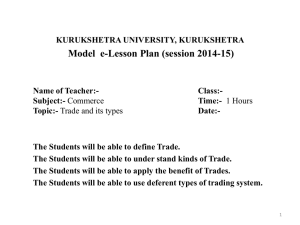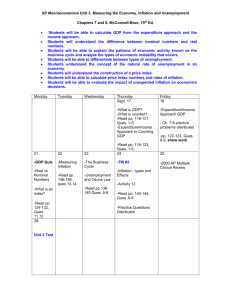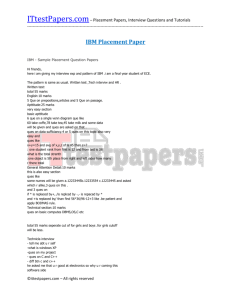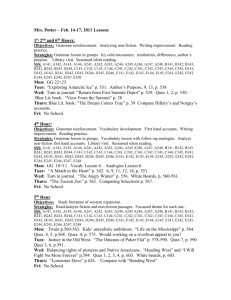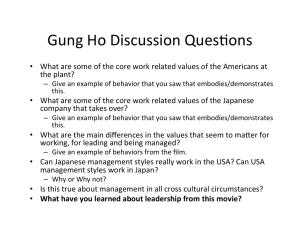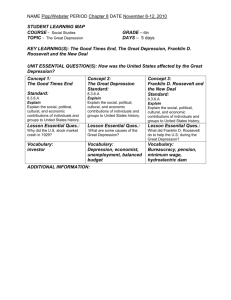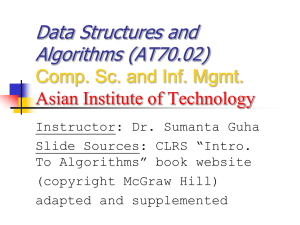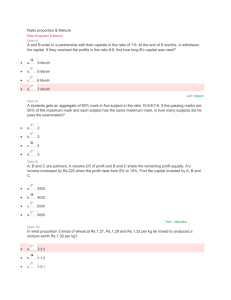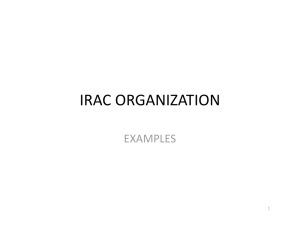NAME: EC 131 -‐ Principles of Microeconomics Fall 2012 FINAL
advertisement
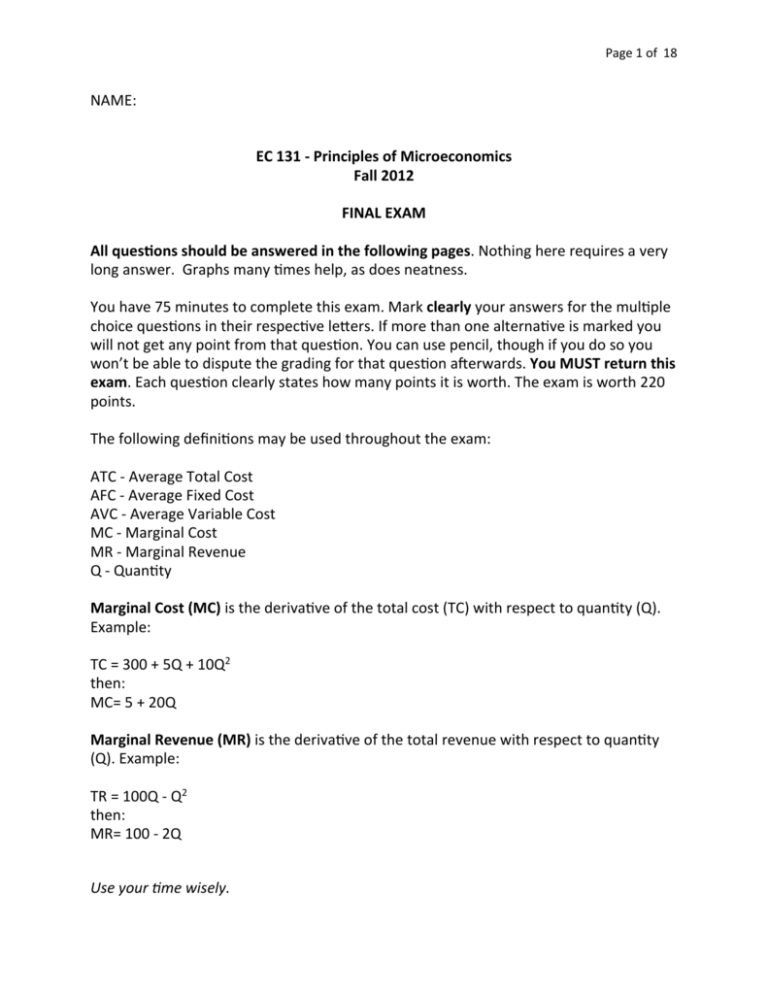
Page 1 of 18 NAME: EC 131 -­‐ Principles of Microeconomics Fall 2012 FINAL EXAM All ques?ons should be answered in the following pages. Nothing here requires a very long answer. Graphs many ;mes help, as does neatness. You have 75 minutes to complete this exam. Mark clearly your answers for the mul;ple choice ques;ons in their respec;ve leEers. If more than one alterna;ve is marked you will not get any point from that ques;on. You can use pencil, though if you do so you won’t be able to dispute the grading for that ques;on aIerwards. You MUST return this exam. Each ques;on clearly states how many points it is worth. The exam is worth 220 points. The following defini;ons may be used throughout the exam: ATC -­‐ Average Total Cost AFC -­‐ Average Fixed Cost AVC -­‐ Average Variable Cost MC -­‐ Marginal Cost MR -­‐ Marginal Revenue Q -­‐ Quan;ty Marginal Cost (MC) is the deriva;ve of the total cost (TC) with respect to quan;ty (Q). Example: TC = 300 + 5Q + 10Q2 then: MC= 5 + 20Q Marginal Revenue (MR) is the deriva;ve of the total revenue with respect to quan;ty (Q). Example: TR = 100Q -­‐ Q2 then: MR= 100 -­‐ 2Q Use your )me wisely. Page 2 of 18 Consider the following produc)vi)es for Orhan and Samson in producing Corn and Pork for ques)ons 1 and 2: Minutes needed to make 1 Bushel of Corn Pound of Pork Samson 20 12 Orhan 15 10 Ques?on 1 -­‐ (10 points) Suppose that Samson can work 6h per day and Orhan can work 8h per day. Fill the blank spaces below with an example of an efficient produc;on for each worker: Bushels of Corn Pounds of Pork Samson 9 15 Orhan 16 24 Ques?on 2 -­‐ (10 points) Fill the following blank spaces: Samson has compara?ve advantage in the produc;on of ____Pork________________ Orhan has compara?ve advantage in the produc;on of ____Corn______________ In order to trade to be beneficial for both, the traded price of pork must be between: ___3/5____________ and ________2/3_______ bushels of corn. Ques?on 3 -­‐ (5 points) Suppose that the equilibrium price of French fries rises while the equilibrium quan;ty falls. The most consistent explana;on for these observa;ons is (mark the correct item): fries) a -­‐ An increase in the price of onion rings (a subs?tute to french fries) b -­‐ A decrease in the price of onion rings c -­‐ An increase in the price of potato bread (a subs?tute in produc?on to french d -­‐ A decrease in the price of potato bread Page 3 of 18 Ques?on 4 -­‐ (5 points) The price elas;city of demand for good X is 0.3. Mark the correct alterna;ve: a. Good X may be a diamond ring b. In the long-­‐run the price elas?city of good X could be 0.5 c. The price elas;city given for good X must be a long-­‐run elas;city d. None of the above is correct Ques?on 5 -­‐ (5 points) You are the CEO of a bagel chain store, which has a monopoly in the sales of bagels, and your marke;ng department comes to you with an es;mate of 1.3 for the price elas?city of demand for bagels. You can, based only on that informa?on, conclude that: (Mark the correct alterna;ve) a. If you increase the unit price of your bagels, your total revenue will decrease b. If you increase the unit price of your bagels, your total revenue will increase c. If you increase the unit price of your bagels, your total revenue will remain the same d. We don’t have enough informa;on to answer this ques;on Ques?on 6 -­‐ (15 points) Consider the US market of donuts. For each scenario presented below, suppose that the market starts from the long-­‐run equilibrium price and quan;ty, and write whether the price and quan;ty change will be INCREASE, DECREASE or AMBIGUOUS a. An european chain of donuts starts its opera;on in the US with 100 stores Price: DECREASE Quan;ty: INCREASE b. A federal law mandates the reduc;on of use of fat in donuts. As a consequence, costs of produc;on of donuts rise and many consumers subs;tute donuts for bagels Price: AMBIGUOUS Quan;ty: DECREASE c. The canadian government gives tax incen;ves for donut bakers to move to Canada, and as a result many leave the US market. (Hint: what will happen to the wage paid to donut bakers in the US?) Price: INCREASE Quan;ty: DECREASE Page 4 of 18 Consider the following demand and supply curves for 3 different consumers and 3 different firms in the market of iPhone cases, which is perfectly compe11ve, for ques)ons 7 and 8. Consumer 1 9 9 8 8 7 7 6 6 5 5 4 4 3 3 2 2 1 1 0 0 1 2 3 4 5 6 7 8 Firm 1 10 P P 10 9 10 11 12 13 14 0 15 0 1 2 3 4 5 6 7 Q 8 8 7 7 6 6 P P 9 5 4 3 3 2 2 1 1 1 2 3 4 5 6 7 8 9 10 11 12 13 14 0 15 0 1 2 3 4 5 Q 9 9 8 8 7 7 6 6 5 4 3 3 2 2 1 1 2 3 4 5 6 7 8 Q 14 15 6 7 8 9 10 11 12 13 14 15 8 9 10 11 12 13 14 15 5 4 1 13 Firm 3 10 P P Consumer 3 0 12 Q 10 0 11 5 4 0 10 Firm 2 10 9 0 9 Q Consumer 2 10 8 9 10 11 12 13 14 15 0 0 1 2 3 4 5 6 7 Q Page 5 of 18 Ques?on 7 -­‐ (5 points) Draw in the box below the market demand and market supply curves for the market for the market of iPhone cases. Pay special a^en?on to the values of the intercepts. Indicate the market equilibrium price and quan?ty. 17 16 15 14 13 12 11 10 P 9 8 7 6 5 4 P* 3 2 1 0 0 1 2 3 4 5 6 7 8 9 10 11 12 13 14 Q* 15 16 17 18 19 20 21 22 23 24 25 26 27 28 29 30 Q Ques?on 8 -­‐ (5 points) Suppose that consumer 2 and firm 2 exit the market. Repeat ques;on 7 for this new economy. 17 16 15 14 13 12 11 10 P 9 8 7 6 5 4 P* 3 2 1 0 0 1 2 3 4 5 6 7 Q* 8 9 10 11 12 13 14 15 Q 16 17 18 19 20 21 22 23 24 25 26 27 28 29 30 Page 6 of 18 Ques?on 9 -­‐ (5 points) The equilibrium price of cheese is $5 per lb. The price-­‐elas;city of demand for cheese is 1.3. The price elas;city of supply of cheese is 1.5. Suppose that the government wants to impose a tax of $1 per lb of cheese, to be paid for by the sellers. Mark the incorrect alterna;ve: a. The tax will lead to a decrease in consump;on of cheese b. If the tax was levied on the consumers, the consump;on of cheese would be the same than if the tax was levied on the sellers c. The deadweight loss generated by the tax would be lower if the elas;ci;es were 0.5 and 0.7 (instead of 1.3 and 1.5) d. The suppliers will pay a bigger share of the tax burden Tax Revenue While studying taxa)on, we saw the curve below, called the Laffer curve, that shows how tax revenue changes with the value of the tax levied. Consider it when answering ques)on 10: Tax rate Ques?on 10 -­‐ (5 points) One of the consequences of the Laffer curve is that in general it is possible to obtain the same tax revenue from two different tax rates. Let t and t’ be two such rates where t>t’ and both yield the same tax revenue. Mark the incorrect alterna;ve: a. b. c. d. The consumer surplus under t is lower than under t’ The deadweight loss under t is higher than under t’ The producer surplus under t is lower than under t’ It is necessary to know the elas?ci?es of supply and demand in order to determine the items above Page 7 of 18 Use the following graph of a market with its demand and supply curves in bold thick line for ques)ons : 15 14 F 13 12 11 C E D A B H G 10 9 L J I K M P 8 O N 7 S 6 U V T Q P Z 5 4 X R A2 3 2 0 0 H2 G2 1 E2 C2 L2 F2 1 D2 B2 2 3 4 I2 5 6 7 J2 8 9 10 11 K2 12 13 14 Q The following ques;ons should be answered directly in the boxes in front of them. Write your welfare analysis answers as summa?ons of the le^ers in the graph above. No explana?ons are necessary. Example: A+B+C. If the answer is ZERO, indicate so by wri?ng “ZERO”. 15 Page 8 of 18 Ques?on 11 -­‐ (10 points) Suppose that markets are free, without taxes and closed to interna;onal trade. Indicate the areas corresponding to the following values: Consumer Surplus A+B+I+J+K Producer Surplus P+Q+S+R+X+F2 Ques?on 12 -­‐ (10 points) Suppose now that the government imposes a tax on producers of $5 per unit sold. Indicate the areas corresponding to the following values: Consumer Surplus A+B Producer Surplus R+X+F2 Tax Revenue I+J+P+Q Deadweight Loss K+S Ques?on 13 -­‐ (10 points) Suppose now that the government ins;tutes a price ceiling of $3. Answer the ques;on below and indicate the areas asked: Is the price ceiling binding? If so, will there be a surplus or a shortage? By how many units? Yes. There will be a shortage of 9 units. Consumer Surplus A+I+P+R Producer Surplus F2 Deadweight Loss B+J+Q+X+K+S Page 9 of 18 Ques?on 14 -­‐ (10 points) Suppose that the country opens to trade and the world price is PW=$3.00 . Is this country going to import or export that good? Import Indicate the areas corresponding to the following values: Consumer Surplus A+B+I+J+K+P+Q+S+T+R+X+A2+B2+C2 Producer Surplus F2 Gains from Trade T+A2+B2+C2 Ques?on 15 -­‐ (10 points) Suppose that aIer opening to trade as in ques;on 14 the government decides to impose an import quota of 5 units. Indicate the areas corresponding to the following values: Consumer Surplus A+B+I+J+K+P+Q+S+T Producer Surplus F2+R+X Gains from Trade T+B2 Deadweight Loss A2+C2 Ques?on 16 -­‐ (5 points) Which of the following statements is not correct? a. Fixed costs are constant b. Variable cost changes as output changes c. Average fixed costs are constant d. Average total costs are typically u-­‐shaped Page 10 of 18 Ques?on 17 -­‐ (10 points) Fill the missing values for the following costs: Output FC VC TC AFC AVC ATC MC 0 1080 0 1080 ----- ----- ----- 400 1 1080 400 1480 1080 400 1480 450 2 1080 850 1930 540 425 965 500 3 1080 1350 2430 360 450 810 550 4 1080 1900 2980 270 475 745 ----- Ques?on 18 -­‐ (5 points) You own a company which has a monopoly in the market of hockey helmets and hired an economist to figure out what would be the best way to increase your profits. AIer a couple of weeks, he comes back with the following informa;on: -­‐ The fixed cost is $50. -­‐ When producing 99 units, AVC was $2 -­‐ When producing 100 units AVC was $2.1 -­‐ The increase in revenue from the increase from 99 to 100 units was $9 Based only on the informa;on provided, mark the correct item: a. b. c. d. It would be beEer to shut-­‐down in the short-­‐run The quan;ty that will maximize profit is bigger than 100 Profits increase if quan?ty is reduced from 100 to 99 You should make the economist recalculate those values, because they must be wrong Page 11 of 18 Ques?on 19 -­‐ (5 points) Your company also has a division that produces toothpaste, a monopolis?cally compe??ve market. The economist gave the following informa;on regarding that market: -­‐ The fixed cost is $500. -­‐ The marginal cost is constant and equal to $2 -­‐ When producing 100 units ATC was $5 -­‐ The increase in revenue from the increase from 99 to 100 units was $4 Based only on the informa;on provided, mark the correct item: a. b. c. d. Profits when producing $100 are nega;ve The quan;ty that will maximize profit is bigger than 100 Profits increase if quan;ty is reduced from 100 to 99 You should make the economist recalculate those values, because they must be wrong Ques?on 20 -­‐ (5 points) On the subject of tradable pollu?on permits (TPP), mark the incorrect item: a. One nega;ve aspect of TPPs is that there is no incen;ve to the market as a whole to reduce total emissions to below the total amount of permits distributed b. They will lead the market to emit the socially efficient amount of pollutants c. Firms that have a rela;ve low cost of reducing emissions will earn higher profits by selling permits d. A firm that has a cost of $500 per ton of emissions reduced will accept to buy permits sold for $400 per ton of emissions Use the graph below for ques)on 21: Page 12 of 18 Ques?on 21 -­‐ (5 points) Suppose that the Lorenz curve in page 11 was made for a country with only 10 residents, and that the total income earned by all of them was $2,000 in both 2009 and 2010. Mark the correct alterna;ve: a. These curves cannot be consistent with a popula;on of only 10 residents b. The poorest 3 individuals, combined, earn, combined, more than $300 c. The Gini coefficient in 2009 is higher than in 2010 d. The richest individual in this country earns more than $400 Use the following values for the willingness to pay for these 4 individuals per acre of a public park (a public good) in ques)on 22: Acres Utku Tayfun Hideo Uzi 1 $30 $21 $25 $15 2 $21 $15 $21 $10 3 $15 $10 $15 $5 4 $10 $0 $5 $0 Ques?on 22 -­‐ (5 points) Suppose that the cost of building a park is of $40 per acre. Consider the efficient alloca?on in this market. Supposing that the government will pay for the park by sharing the cost of it equally among the four individuals (that is, each one will pay a tax of $10 per acre), mark the alterna;ve that shows, in order, the number of acres produced, Utku’s consumer surplus, and Uzi’s consumer surplus: a. 0 , $0 , $0 b. 3 , $66 , $25 c. 3 , $36 , $0 d. 2 , $36 , $0 Page 13 of 18 Ques?on 23 -­‐ (30 points) Consider a profit maximizing firm, in a perfectly compe??ve market, with the following total cost (TC) func;on: TC = 3 + 3Q + 0.2Q2 a) Find the expressions for the Marginal Cost (MC), Average Total Cost (ATC), Average Fixed Cost (AFC) and Average Variable Cost (AVC) for this firm b) Suppose that the market price is P=$7.00. Find the quan;ty produced (Q), Total Revenue (TR), Total Cost (TC) and and Profit for that firm at that price. Will the long-­‐run price be higher or lower than $7.00? Jus?fy (based only on the results from this item b) ) Page 14 of 18 c) Find the long-­‐run quan;ty produced (Q) and price (P) for this market. Page 15 of 18 Ques?on 24 -­‐ (30 points) Consider now a profit maximizing firm, in a monopolis?cally compe??ve market, with the same total cost func?on as the firm in ques?on 21, facing the following inverse demand curve: P = 6-­‐0.4Q a) Find the quan;ty produced (Q), the price (P) and the Profit obtained by this firm Page 16 of 18 b) Plot a graph with the Demand Curve (D), the Marginal Revenue curve (MR) and the Marginal Cost curve (MC). Write down carefully and precisely the values at the intercepts. Point out the areas represen;ng the Consumer Surplus (CS), the Producer Surplus (PS) and the Deadweight Loss (DWL). Page 17 of 18 c) Will this firm produce more, less or the same quan;ty in the long-­‐run? Jus;fy. Page 18 of 18 BONUS QUESTION -­‐ (Op;onal) Choose an integer number between 0 and 100. If the difference between your number and half of the average number among all numbers given by the class is at most 3 you get an extra 15 points in this exam. If more than one student chooses the same number in the correct range, the 15 points will be divided among them Example 1: Average number given by the class: 50. Half of the class average is 25. If your guess is 27 and nobody else guesses 27 you get extra 15 points. Example 2: Average number given by the class: 50. Half of the class average is 25. If your guess is 23 and other two student guess 23, all of you who guessed 23 get extra 5 points. Your number:
